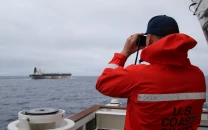Trump to visit deluged Texas to survey response to storm Harvey
Trump will arrive on Tuesday morning in Corpus Christi

U.S. President Donald Trump waves as he walks with first lady Melania Trump on South Lawn of the White House upon their return to Washington, US, from Camp David. PHOTO: REUTERS
The slow-moving storm has killed at least eight people and paralysed Houston, the fourth most-populous US city, with unprecedented flooding.
It had also roiled energy markets and caused damage estimated to be in the billions of dollars, with rebuilding likely to last beyond Trump’s current four-year term in office.
Harvey versus Katrina: a world of differences
“My administration is coordinating closely with state and local authorities in Texas and Louisiana to save lives, and we thank our first responders and all of those involved in their efforts,” Trump told reporters at the White House on Monday.
Trump will arrive on Tuesday morning in Corpus Christi, near where Harvey came ashore on Friday as the most powerful hurricane to hit Texas in more than 50 years. The president will later go to the Texas capital, Austin, to meet state officials, receive briefings and tour the emergency operation center, the White House said.
Forecasters could only draw on a few comparisons to the storm, recalling Hurricane Katrina, which devastated New Orleans and killed 1,800 people in 2005.
The administration of then President George W. Bush faced accusations of launching a slow and inadequate response, dealing a political blow to Bush’s presidency.
Flood damage in Texas from Hurricane Harvey may equal that from Katrina, one of the costliest natural disaster in US history, an insurance research group said on Sunday.
In Texas, thousands of National Guard troops, police officers, rescue workers and civilians raced in helicopters, boats and high-water trucks to rescue the thousands stranded in the flooding that turned streets into rivers and caused chest-high water build-ups in scores of neighborhoods.
In Cypress, Texas, Kayla Harvey, 26, has been monitoring Facebook, finding where people are stuck and organising friends with boats to go out and help. “This is just what we do for our community. We don’t wait for someone to come and help we just go out and do it,” she said.
Hurricane Harvey menaces Texas, Louisiana
RUNWAYS TURNED INTO LAKES
Since coming ashore, Harvey has virtually stalled along the Texas coast, picking up warm water from the Gulf of Mexico and dumping torrential rain from San Antonio to Louisiana.
The Houston metro area has suffered some of the worst precipitation with certain areas expected to receive more than 50 inches (127 cm) of rain in a week, more than they typically receive for a year.
Harvey is expected to produce another 10 to 20 inches of rain through Thursday over parts of the upper Texas coast into southwestern Louisiana, the National Weather Service said.
“These stationary bands of tropical rain are very hard to time, very hard to place and are very unpredictable,” said Alek Krautmann, a National Weather Service meteorologist in Louisiana.
Schools and office buildings were closed throughout the Houston metropolitan area, home to 6.8 million people.
The Federal Emergency Management Agency director Brock Long estimated that 30,000 people would eventually be housed temporarily in shelters. Houston and Dallas have set up a shelters in convention centers and Austin is preparing to house as many as 7,000 evacuees.
Hundreds of Houston area roads were blocked by high water. The city's two main airports were shut as the floods turned runways into ponds and more than a quarter million customers were without power as of Tuesday morning.
Houston floods spark chaos, much more rain to come
The Gulf of Mexico is home to almost half of the nation's refining capacity. The reduced supply led gasoline futures to hit their highest in two years this week as Harvey knocked out about 13 percent of total US refining capacity, based on company reports and Reuters estimates. The floods could destroy as much as $20 billion in insured property, making the storm one of the costliest in history for US insurers, Wall Street analysts say.



















COMMENTS
Comments are moderated and generally will be posted if they are on-topic and not abusive.
For more information, please see our Comments FAQ